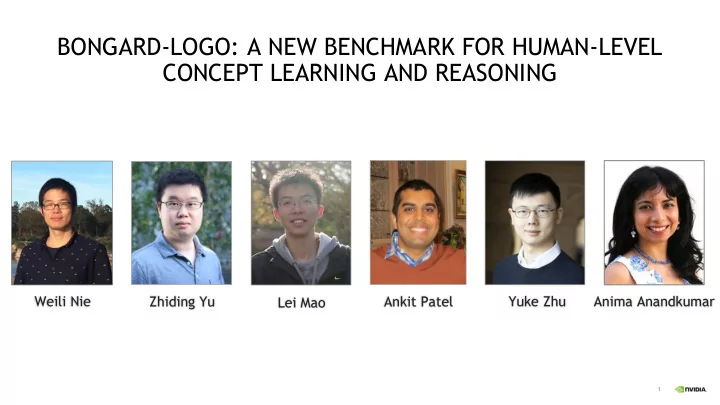

BONGARD-LOGO: A NEW BENCHMARK FOR HUMAN-LEVEL CONCEPT LEARNING AND REASONING Weili Nie Zhiding Yu Ankit Patel Yuke Zhu Anima Anandkumar Lei Mao 1
BACKGROUND: BONGARD PROBLEMS One Hundred puzzles originally invented by M. M. Bongard in 1967 set A set B ● Bongard aimed to demonstrate the key properties of human visual cognition capabilities. Given a set A of six images (positive examples) and ● another set B of six images (negative examples), the objective is to discover the concept that the ● images in set A obey and images in set B violate. Problem #13 (A neck) 2
AN OVERVIEW OF BONGARD-LOGO A benchmark inspired by original BPs for human-level visual concept learning and reasoning ● It transforms concept learning into a few-shot binary classification problem It consists of 12,000 problem instances ● The large scale makes it digestible by advanced machine learning methods in modern AI ○ ● The problems in Bongard-LOGO belong to three types based on the concept categories: 3,600 Free-form shape problems ○ 4,000 Basic shape problems ○ 4,400 Abstract shape problems ○ 3
THREE TYPES OF BONGARD-LOGO PROBLEMS (Concept: “ice cream cone”-like (Concept: A combination of “fan”-like (Concept: “convex”) shape) shape and “trapezoid”) 4
KEY PROPERTIES OF BONGARD-LOGO It captures three core properties of human cognition exhibited in original BPs ● Context-dependent perception The same shape pattern has fundamentally opposite interpretations depending on the context ○ 5
KEY PROPERTIES OF BONGARD-LOGO It captures three core properties of human cognition exhibited in original BPs ● Analogy-making perception Some meaningful structures (i.e., zigzags or a set of circles) can be projected onto another meaningful ○ ones (i.e., straight lines or arcs) for underlying concepts 6
KEY PROPERTIES OF BONGARD-LOGO It captures three core properties of human cognition exhibited in original BPs ● Perception with a few examples but infinite vocabulary There is no finite set of categories to name and describe the geometrical arrangements ○ 7
PROBLEM GENERATION Automatically generating problems with action-oriented language ● We use LOGO language for procedural generation: The procedural commands for drawing each shape form its ○ ground-truth action program Each action program is a list of actions and each action is ○ depicted by a function: [Action name] ( [moving type], [moving length] , [moving angle] ) ● Two benefits: Easily generate arbitrary shapes and precisely control the shape ○ variation in a human-interpretable way Provide a useful supervision in guiding symbolic reasoning in the ○ action space Action Programs 8
BENCHMARKING ON BONGARD-LOGO Comparing SOTA few-shot learning methods with human performance Test accuracy (%) on free-form shape test set ( FF ), basic shape test set ( BA ), combinatorial abstract shape test set ( CM ), and novel abstract shape test set ( NV ). Human (Expert) refers to human subjects who carefully follow our instructions while Human (Amateur) do not. The chance performance is 50%. There is a significant gap between model and human performance 9
INCORPORATING SYMBOLIC INFORMATION Meta-baseline based on program synthesis (Meta-Baseline-PS) Stage I: Train the program synthesis module to predict action programs Stage II: Use the pre-trained image feature to fine-tune the meta-learner 10
INCORPORATING SYMBOLIC INFORMATION Meta-baseline based on program synthesis (Meta-Baseline-PS) Test accuracy (%) on free-form shape test set ( FF ), basic shape test set ( BA ), combinatorial abstract shape test set ( CM ), and novel abstract shape test set ( NV ). Human (Expert) refers to human subjects who carefully follow our instructions while Human (Amateur) do not. The chance performance is 50%. Meta-Baseline-PS clearly outperforms previous SOTA methods 11
SUMMARY A new benchmark for human-level visual concept learning and reasoning ● Bongard-LOGO scales up one Hundred original Bongard problems to a large dataset Bongard-LOGO demands a new form of human-like perception that is context-dependent, analogical, and of ● infinite vocabulary We developed a program-guided shape generation technique to produce Bongard-LOGO shapes in action-oriented ● LOGO language ● Large performance gap between human and machine in Bongard-LOGO reveals a failure of today's pattern recognition systems in capturing the core properties of human cognitive learning and reasoning. ● We showed that incorporating symbolic information into neural networks improves the overall performance, suggesting the advantages of neuro-symbolic methods on Bongard-LOGO 12
Recommend
More recommend